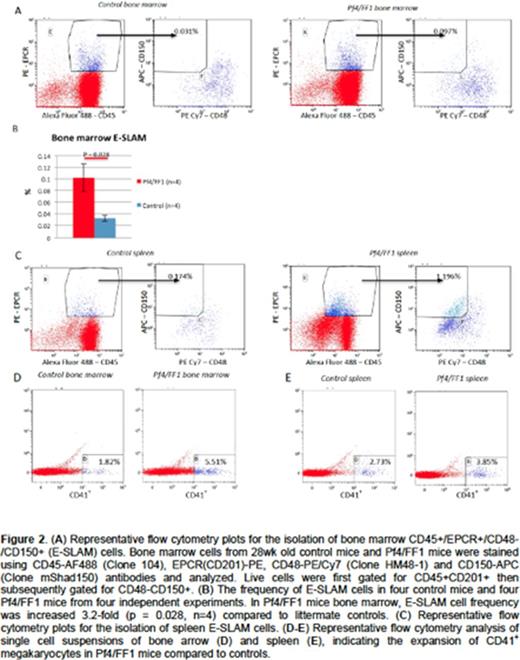Abstract
Introduction
The myeloproliferative neoplasms (MPNs), including essential thrombocythemia (ET), are characterized by unregulated hematopoietic stem cell (HSC) expansion and overproduction of blood cells. The JAK2V617F mutation can be found in majority of MPN patients, but the mechanisms responsible for the MPN stem cell expansion remain incomplete. One hallmark feature of MPNs is megakaryocyte (MK) hyperplasia. We hypothesize that JAK2V617F -mutant MKs contribute to MPN pathogenesis by promoting HSC expansion.
Methods
JAK2V617F Flip-Flop (FF1) mice and Pf4-Cre mice (from Radek Skoda, Switzerland) were crossed to generate a MK cell lineage-specific human JAK2V617F knock-in mouse strain (Pf4/FF1). Animal experiments were performed in accordance with the Institutional Animal Care and Use Committee guideline. Mice were sacrificed at 28 wk of age. Bone marrow and spleen cell flow cytometry analysis was performed on a FACSAriaTM III (BD). Mouse methylcellulose media and Megacult-C media (Stem Cell Technologies) were used to assay colony formation. The TaqMan¨ Gene Expression Assay (Applied Biosystems) was used for quantitative real-time polymerase chain reaction (qRT-PCR) to verify differential expression of fibroblast growth factor 1 (FGF1), platelet factor 4 (Pf4), transforming growth factor beta 1 (TGFb-1), chemokine (C-X-C motif) ligand 12 (CXCL12). For HSC transplantation experiments, wild-type CD45.1+ recipient mice (B6.SJL, Taconic) were lethally irradiated (950 cGy) and then received 5 x 106 nucleated marrow cells from Pf4/FF1 or age-matched littermate control mice (CD45.2).
Results
Thrombocytosis was observed in Pf4/FF1 mice at 16wk of age. At 28wk there was a significant increase in platelet count (1406 vs. 808 x 109/L, p = 0.0009) in Pf4/FF1 mice but no change was noted in hemoglobin or white blood cell count compared with age-matched littermate controls. Splenomegaly was observed in 28wk old Pf4/FF1 mice compared to controls (spleen weight 0.101 vs. 0.070 gram, p = 0.040). Marrow cell colony assays demonstrated an increase in total hematopoietic progenitors (1.8-fold, p = 0.007) and in MK-committed progenitors (1.9-fold, p = 0.00009) in Pf4/FF1 mice compared to controls (Figure 1). Marrow cell flow cytometry analysis revealed that CD45+ EPCR+ CD48- CD150+ (E-SLAM) cells, a highly purified HSC population, were increased 3.2-fold (p = 0.028, n=4) in Pf4/FF1 mice compared to control mice, although the cells did not express JAK2V617F as determined by RT-PCR for FF1. CD41+ MK cells were also increased in Pf4/FF1 mice (Figure 2). Histologic analysis of marrow sections revealed an increased megakaryopoiesis with more MKs adjacent to the endosteal surface in Pf4/FF1 mice than in controls. In addition, there were dilated marrow sinusoids in Pf4/FF1 mice and sinusoidal endothelial cells (EC) were surrounded by MKs that conformed to the EC morphology (Figure 3). No marrow or spleen fibrosis was observed at 28 wk of age. To more directly test the effects of JAK2V617F -mutant MKs on HSCs, marrow cells from 28-wk old Pf4/FF1 mice or controls (CD45.2) were transplanted into lethally irradiated congenic CD45.1 recipients (n = 5 in each group). By 12 wks post transplantation, recipients of Pf4/FF1 marrow had already developed a higher platelet count (1105 vs. 772 x 109/L, p = 0.025) and a mildly elevated red cell count (10.7 vs. 9.9 x 1012/L, p = 0.017) than mice transplanted with the control marrow. To begin to understand the MK signals responsible for HSC expansion in Pf4/FF1 mice, qRT-PCR of purified CD41+ MK cells identified up-regulation of FGF1 (8.1-fold, p = 0.02), Pf4 (8.0-fold, p = 0.0003), and CXCL12 (3.1-fold, p = 0.005) and down-regulation of TGFβ-1 (75%, p = 0.0005) in Pf4/FF1 mice compared to controls.
Conclusions
Pf4/FF1 mice developed an ET phenotype with thrombocytosis, splenomegaly and increased numbers of E-SLAM HSCs and CD41+ MK cells, despite JAK2V617F expression being restricted to MKs. Marrow histology suggested that both the osteoblastic niche and vascular niche might be affected by the JAK2V617F -mutant MKs. In addition, marrow cells from Pf4/FF1 mice repopulated wild-type recipients and induced a MPN phenotype. MKs from such mice displayed an altered pattern of cytokine expression, possibly contributing to the observed effects but the precise mechanism by which JAK2V617F-bearing MKs affect the MPN marrow niche and HSC expansion deserve further investigation.
No relevant conflicts of interest to declare.
Author notes
Asterisk with author names denotes non-ASH members.




